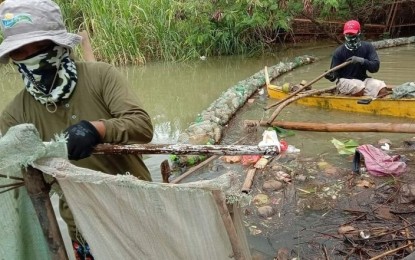
TRASH TRAPS. The Department of Environment and Natural Resources (DENR) in Central Luzon installs 50 trash traps in rivers in the region to prevent solid wastes from reaching the waters of Manila Bay. The floating trash traps, which were made from recycled materials, were put up in Lamao, Orani, Orion, Pinulot, Pangulisanin, Amo, Aguawan, Almacen, Bilolo, Talisay, Mabuco and Samal rivers, all in Bataan, and Guagua-Pasak river in Pampanga. (Photo by DENR-3)
CITY OF SAN FERNANDO, Pampanga – The Department of Environment and Natural Resources (DENR) regional office here has installed 50 trash traps in some rivers in Central Luzon to prevent solid wastes from reaching the waters of Manila Bay.
Paquito Moreno Jr., executive director of DENR in Central Luzon, said on Thursday the floating trash traps, which were made from recycled materials such as plastic and fishing gear and measuring about 30 to 100 meters, were put up in Lamao, Orani, Orion, Pinulot, Pangulisanin, Amo, Aguawan, Almacen, Bilolo, Talisay, Mabuco and Samal rivers, all in Bataan, and Guagua-Pasak river in Pampanga.
“Aside from the regular cleanup, which we are doing every week, these trash traps are another strategy to prevent the accumulation of garbage in the shoreline of our historic Manila Bay. Solid wastes are now being removed from the source before it reaches the bay,” Moreno said in a statement.
DENR record shows that these traps have prevented at least 30 tons of solid waste from reaching the waters of the bay through its various tributaries since they were installed early this year.
The traps are strategically placed in rivers and streams where they can stop solid waste from floating further downstream, without hampering the movements of aquatic life such as fish.
“We have partnered with local government units (LGUs) in the region to manufacture and install these floating trash traps in the rivers within their locality while new traps are continually being installed with their help. Also, our estero rangers regularly collect and characterize the wastes from traps before it can be disposed of in sanitary landfills," he said.
Moreno appealed to the public to support the DENR in its campaign to save Manila Bay and to religiously practice the 3Rs (reduce, reuse and recycle), of solid waste management coupled with discipline to reduce waste generation in the region.
He said it is the commitment of the DENR and the rest of the mandamus agencies to the public to clean Manila Bay.
Manila Bay covers the region of Calabarzon, National Capital Region, and Central Luzon. It has a total of 190 kilometers of coastline.
Of these, 144 kilometers are part of Central Luzon, covering the provinces of Bulacan, Pampanga, and Bataan.
Meanwhile, statistics from the DENR's Environmental Management Bureau (EMB) Region 3 showed that the average solid waste generation of Central Luzon is estimated to be 5,598 tons per year. (PNA)
